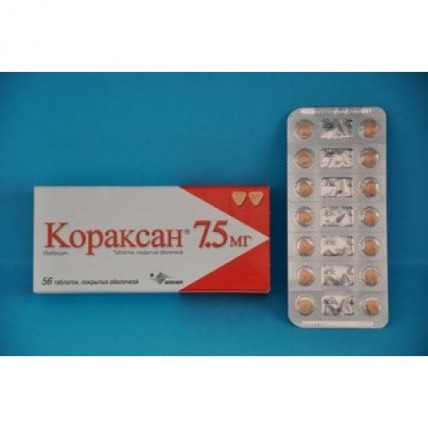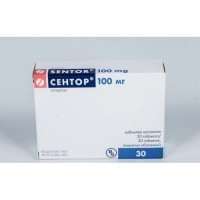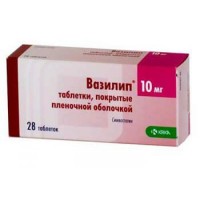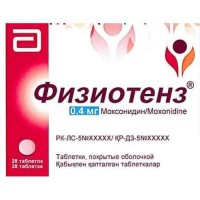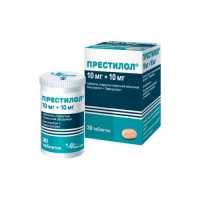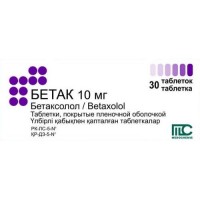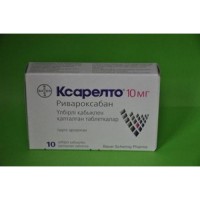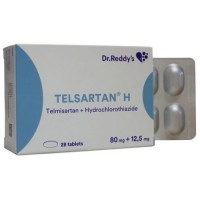Coraxan 56's 7.5 mg coated tablets
- $57.10
The instruction for medical use
of KOPAKCAH medicine
the Trade name
of Koraksan
the International unlicensed
name Ivabradin Lekarstvennaya
the Tablet form, coated 5 mg and 7.5 mg
Structure
One tablet contains
active agent – ivabradin 5 mg or 7.5 mg (5.390 mg or 8.085 mg of an ivabradin of a hydrochloride respectively are equivalent),
excipients: lactoses monohydrate, magnesium stearate, starch corn, maltodextrin, silicon dioxide anhydrous,
film cover: glycerin, a gipromelloza, ferrous oxide yellow E172, ferrous oxide red E172, a macrogoal 6000, magnesium stearate, the titan E171 dioxide
the Description
of the Tablet, coated oranzhevato - pink color, the extended form, with a tag for division on one side (on edges), with an engraving 5 on one party is also familiar on other party (for a dosage of 5 mg)
Tablets, coated oranzhevato - pink color, triangular shape, with an engraving 7.5 on one party and is familiar on other party (for a dosage of 7.5 mg)
Pharmacotherapeutic group
Drugs for treatment of heart diseases. Other drugs for treatment of heart diseases. Other cardiotonic drugs. Ivabradin
the ATX C01EB17 Code
the Pharmacological
Pharmacokinetics Absorption properties and bioavailability
After oral administration ivabradin quickly and almost is completely absorbed in digestive tract. The peak of concentration of drug in plasma at reception is on an empty stomach reached approximately in 1 hour. The absolute bioavailability is about 40% owing to effect of the first passing through intestines and a liver. Meal slows down absorption approximately for 1 hour and increases exposure in plasma by 20-30%. Reception of tablets at meal time allows to reduce exposure fluctuations.
Distribution
Ivabradin approximately for 70% contacts proteins of plasma, the volume of distribution is close to 100 l. The maximum concentration (Cmax) in plasma at constant reception of a dose of 5 mg 2 times a day makes 22 ng/ml (coefficient of variation (CV) = 29%). Average concentration in plasma makes 10ng/l (coefficient of variation (CV) = 38%).
Biotransformation
Ivabradin is substantially metabolized in a liver and intestines by oxidation by P450 3A4 cytochrome (CYP3A4). The main metabolite is N-demetilirovanny a metabolite (S 18982), its exposure makes about 40% of initial connection. CYP3A4 also participates in metabolism of this active metabolite.
Removal
the Main elimination half-life of an ivabradin makes 2 hours of plasma (70-75% of the area under pharmacokinetic curve (AUC)), and final elimination half-life – 11 hours. The general clearance is approximately 400ml/mines, renal clearance – near 70ml/min. Excretion of metabolites happens to the same extent to urine and a stake. About 4% of an oral dose are removed with urine in not changed look.
The kinetics of an ivabradin for dosages from 0.5 to 24 mg is linear.
Pharmacokinetics in special clinical cases
Elderly patients: pharmacokinetic differences (AUC and Cmax) between patients 60let and 75let and population in general were not observed.
When prescribing drug to patients with a renal failure (clearance of creatinine - 15-60 ml/min.) changes of pharmacokinetic indicators are very limited in connection with low participation of renal clearance (about 20%) in the general removal of an ivabradin and its main metabolite S 18982.
At patients with a slight liver failure (up to 7 points on a scale of Chayld-Pyyu) untied AUC of an ivabradin and the main active metabolite is about 20% higher, than at persons with function of a liver is normal.
A pharmacodynamics
of Koraksan – bradikardichesky drug, selectively and specifically inhibiting If channel of the driver of a warm rhythm which plays the main role at spontaneous diastolic depolarization of cells of a sinoatrial node and regulates heart rate. Impact on heart consists in specific action on a sinus node. Drug does not influence time of intra atrial, atrioventricular or intra ventricular carrying out, for sokratitelny activity of a myocardium (without negative inotropic effect) and ventricular repolarization.
The main pharmakodinamichesky property of an ivabradin at the person is specific, dose-dependent decrease in the heart rate (HR). The analysis of decrease in ChSS at the doses exceeding 20 mg 2 times a day indicates a tendency to approach of effect of the plateau that it reduces risk of approach of heavy bradycardia (less than 40 beats/min). At reception of the recommended doses the reduction of ChSS at rest and physical activity is about 10 beats/min. It leads to decrease in load of heart and oxygen consumption by a myocardium.
Koraksan can interact with Ih channel of a retina which is in many respects similar to If channel also. He participates in temporary resolving power of a visual system as he reduces reaction of a retina to stimulation by bright light. In certain circumstances (for example, rapid changes of illumination) Koraksan partially inhibits an electric impulse of Ih that sometimes at some patients leads to emergence of light feelings (phosphene) which are described as short-term feeling of the increased brightness in a limited part of a field of vision.
The efficiency of drug in a dose of 5 mg 2 times a day is shown within 3-4 weeks after an initiation of treatment. The efficiency was confirmed also for a dose of 7.5 mg two times a day. At the lowest activity of drug the general duration of physical activity increases approximately for 1 minute after one month of reception of a dosage of 5 mg 2 times a day, the subsequent increase almost for 25 seconds happens after the additional three-months period to the forced titration to 7.5 mg 2 times a day. The efficiency of dosages of 5 and 7.5 mg at reception 2 times a day is observed in testing parameters with physical activity (the general duration of loading, time before limited stenocardia, time before stenocardia and time before appearance of a depression of a segment of ST for 1 mm). This efficiency is followed by decrease in frequency of attacks of stenocardia approximately by 70%. At administration of drug 2 times a day are provided uniform efficiency of action within 24 hours.
At reception of Koraksana in a combination with atenolol of 50 mg the additional effect on parameters of the exercise tolerance test is noted at the minimum activity of drug once a day (in 12 hours after oral administration).
Koraksan completely keeps the efficiency during 3-4 monthly courses of treatment. Signs of development of pharmacological tolerance during treatment or a withdrawal at the sudden termination of treatment do not nablyudtsya.
Dose-dependent decrease in ChSS and significant reduction of the so-called double work (ChSS multiplied by the systolic arterial blood pressure (SABP)) at rest and at physical activity causes antianginal and antiischemic action of Koraksana. Influence of drug on the arterial blood pressure (ABP) and peripheric resistance of vessels is insignificant a little.
At patients with diabetes the antianginal and antiischemic efficiency remains, safety profile at the same time is similar to safety profile at the patients who do not have diabetes.
Long decrease in ChSS is observed at administration of drug within not less than 1 year. Influence on metabolism of glucose and fats does not happen.
Decrease in frequency of hospitalization concerning a fatal and not fatal myocardial infarction for 36% (r =0.001), frequencies of need of coronary revascularization for 30% (r =0.016), decrease in frequency of cardiovascular mortality at patients with stable stenocardia for 24% (r =0.05) and considerable decrease in level of hospitalization concerning an acute myocardial infarction for 42% is authentically proved (r =0.021). This reduction of risk of hospitalization concerning an acute fatal and not fatal myocardial infarction was even more (73%, r =0.002) at patients with stenocardia and ChSS & gt, 70 blows/min.
It is also authentically proved that at patients with moderate and heavy symptoms of chronic and heart failure, with reduced fraction of emission of a left ventricle (LVEF of ≤35%) receiving standard therapy (β-blockers, AKF inhibitors and/or antagonists of receptors of angiotensin II, diuretics antialdosteronovy drugs) at addition of an ivabradin statically significant decrease in relative risk of cardiovascular mortality and hospitalization concerning exacerbation of heart failure for 18% (the relation of risks ivabradin / is observed by placebo: 0.82, D of 95%
– р<, 0.0001). Absolute risk reduction made 4.2%. The effect of treatment was shown within 3 months after the beginning of therapy. This risk reduction was consecutive irrespective of age, sex, a class on NYHA, reception of β-blockers, an ischemic or not ischemic etiology, heart failure and diabetes or hypertensia in the anamnesis. Treatment ivabradiny during 1 year helps to prevent one cardiovascular mortality or hospitalization with heart failure at every 26th patient. Besides considerable improvement on the class NYHA (at 887 is noted (28%)) the patients accepting ivabradin in comparison with 776 (24%) patients, the receiving placebos) (r =0.001).
Treatment ivabradiny was followed by decrease in ChSS on average by 15 beats/min from a reference value of 80 beats/min which remained for treatment.
Indications
- treatment of chronic stable stenocardia at the patients having a coronary artery disease with a normal sinoatrial rate and with ChSS rhythm ≥ 70 beats/min:
- at intolerance or contraindications to beta-blockers
- in a combination with beta-blockers at patients, at inadequate (insufficient) control of a state an optimum dose of beta-blockers, treatment of chronic heart failure of the II-IV degree on classification of NYHA (New York cardiological association) with systolic dysfunction, at patients with a sinoatrial rate, with clinical symptoms of chronic heart failure and ChSS ≥ 75 beats/min, in combination with standard therapy, including beta-blockers and also at intolerance or a contraindication of beta-blockers
the Route of administration and doses
Treatment of chronic stable stenocardia
the Initial recommended dose makes 5 mg 2 times a day at patients 75 years are younger. In 3-4 weeks of use if the patient still has no symptoms if the initial dose is well transferred and ChSS at rest remains higher than 60 beats/min, to the patients receiving 2.5 mg two times a day or 5 mg two times a day, it is possible to increase a dose to the following mark. The maintenance dose should not exceed 7.5 mg two times a day.
If symptoms of stenocardia do not improve within 3 months after an initiation of treatment, ivabradin it is necessary to cancel.
It is necessary to take a pill orally 2 times a day – in the morning and in the evening at meal time.
If during treatment of ChSS does not exceed 50 beats/min at rest or at the patient the symptoms connected with bradycardia (dizziness, fatigue, hypotension) are observed, the dose has to be titrated towards reduction, up to the minimum dose of 2.5 mg 2 times a day (1/2 tablets of 5 mg twice a day). After a dose decline it is necessary to continue control of ChSS.
Treatment should be stopped if heart rate remains lower than 50 beats/min or symptoms of bradycardia do not pass despite a dose decline.
Treatment of chronic heart failure
the Initial recommended dose makes 5 mg 2 times a day. After 2 weeks of treatment the dose can be increased up to 7.5 mg 2 times a day if ChSS at rest steadily does not decrease lower than 60 beats/min. In case ChSS steadily does not rise higher than 50 beats/min or in case of manifestation of the accompanying symptoms of bradycardia, such as dizziness, fatigue or hypotension, a dose can be reduced up to 2.5 mg twice a day (1/2 tablets of 5 mg twice a day).
If ChSS makes from 50 to 60 beats/min, the dose of 5 mg 2 times a day remains without changes.
If during treatment of ChSS higher than the level of 50 beats/min at rest persistently does not rise or at the patient 2 times a day are observed bradycardia symptoms, a dose of drug of 7.5 mg or 5 mg it is necessary to titrate on 1 step towards reduction.
If at the patients receiving drug in a dose of 2.5 mg twice a day or 5 mg twice a day ChSS at rest steadily remains at the level more than 60 beats/min, the dose of drug can be titrated on one step towards increase.
If ChSS remains lower than 50 beats/min or symptoms of bradycardia do not pass, treatment is stopped.
Elderly patients
to Patients at the age of 75 years are also more senior it is necessary to appoint lower initial dosage – 2.5 mg 2 times a day (1/2 tablets of 5 mg twice a day). Further increase in a dose of drug is possible.
The renal failure
For patients with a renal failure and clearance of creatinine more 15ml/mines corrections of a dose is not required. When prescribing drug the patients with clearance of creatinine lower than 15 ml/min. should be careful with a renal failure.
The liver failure
For patients with a slight liver failure of correction of a dose is not required. When prescribing drug the patients should be careful with a moderate liver failure.
Pediatric population
Safety and efficiency of an ivabradin at children and teenagers aged up to 18 years is studied insufficiently. Data on use of drug for this category of patients are absent.
Side effects
Very often (≥1/10)
- light feelings (phosphene) (see the section Pharmacodynamics), as a rule, the treatments arising in the first 2 months then can arise again. Phosphene stops during treatment (in most cases (77.5%)) or after its termination
is frequent (≥1/100, & lt, 1/10)
- bradycardia, especially in the first 2-3 months of treatment
- atrioventricular block І degrees
- ventricular extrasystoles
- fibrillation of auricles
- disturbance of clearness of sight
- uncontrollable arterial blood pressure
- a headache, usually within the first month of treatment
- the dizziness which is perhaps connected with bradycardia
Infrequently (≥1/1000, & lt, 1/100),
- a cardiopalmus, supraventricular extrasystoles
- vertigo
- short wind
- the hypotension which is perhaps connected with bradycardia
- muscular spasms
- nausea, a constipation, diarrhea, an abdominal pain
- a hyperuricemia, an eosinophilia
- the faints which are perhaps connected with bradycardia
- a Quincke's disease
- skin rash
- doubling in eyes, a disorder of vision
- the asthenia which is perhaps caused by bradycardia
- the exhaustion which is perhaps connected by bradycardia
- increase in level of creatinine in blood
- the increased QT interval on the ECG
is rare (³1/10000, & lt, 1/1000)
- an erythema, an itching, a small tortoiseshell
- the discomfort which is perhaps caused by bradycardia
Very seldom (& lt, 1/10000)
- an atrial fibrillation
- atrioventricular block of ІI of degree
- atrioventricular block of ІII of degree
-
the Contraindication sick sinus syndrome
- hypersensitivity to active agent or to one of excipients
- ChSS at rest prior to treatment is lower than 70 beats/min
- cardiogenic shock
- an acute myocardial infarction
- heavy hypotension (& lt, 90/50 mm Hg)
- a heavy liver failure
- a sick sinus syndrome
- sinuatrial blockade, unstable or
an acute heart failure
- existence of an electrocardiostimulator (if ChSS depends only on an electrocardiostimulator)
- unstable stenocardia
- atrioventricular block ІІІ of degree
- combination therapy with strong inhibitors of P450 3A4 cytochrome: azolny antifungal drugs (ketokonazol, itrakonazol), makrolidny antibiotics (klaritromitsin, erythromycin orally, dzhozamitsin, telitromitsin), by HIV protease inhibitors (nelfinavir, ritonavir) and nefazodony
- combination therapy with verapamil or diltiazem which are the moderate CYP3A4 inhibitors reducing ChSS
- pregnancy and the period of a lactation, the woman of childbearing age not applying contraceptive means
- the children's and teenage age up to 18 years
Medicinal interactions
is not recommended the combined reception of an ivabradin with the drugs extending QT interval such as:
- cardiovascular drugs: quinidine, Disopyramidum, bepridit, sotalol, ibutilid, Amiodaronum
- the drugs which are not intended for treatment of diseases of a cardiovascular system (Pimozidum, ziprazidon, sertindol, meflokin, galofantrit, pentamidine, sizaprid, erythromycin for intravenous administration)
Kaliysberegayushchy diuretics (thiazide and loopback diuretics): the hypopotassemia can lead to increase in risk of developing of arrhythmia. As ivabradin can cause bradycardia, the received combination of a hypopotassemia and bradycardia is the contributing factor for manifestation of heavy arrhythmia, especially at patients with a syndrome of a long QT interval, regardless inborn or caused by drugs.
In need of purpose of such combinations it is necessary to carry out careful monitoring of cardiac performance.
Use of an ivabradin together with strong inhibitors of CYP3A4 enzyme (azolny antifungal drugs (ketokonazol, itrakonazol), makrolidny antibiotics (klaritromitsin, erythromycin orally, dzhozamitsin, telitromitsin), HIV protease inhibitors is contraindicated (nelfinavir, ritonavir), nefazodon).
Powerful inhibitors of an isoenzyme CYP3A4 - ketokonazol (once a day) and dzhozamitsin (1 g two times a day) - led 200 mg to increase in average exposure of an ivabradin in plasma by 7-8 times.
Combined use of drug with moderate CYP3A4 inhibitors is not recommended (diltiazem, verapamil, flukonazol). Joint reception is possible at an initial dose of 2.5 mg 2 times a day provided that ChSS at rest makes more than 70 beats/min, with carrying out monitoring of ChSS.
The inductors CYP3A4 (rifampicin, barbiturates, Phenytoinum, drugs of a St. John's wort of made a hole (Hypericum perforatum)) lead to decrease in concentration in plasma and to reduction of activity of an ivabradin. The concomitant use can demand to dose adjustment of an ivabradin or reduction of doses of the above-mentioned inductors CYP3A4. During treatment ivabradiny administration of drugs of the St. John's wort which is made a hole needs to be reduced.
The concomitant use of grapefruit juice increases exposure of an ivabradin twice in this connection during treatment ivabradiny it is necessary to reduce consumption of grapefruit juice.
Inhibitors of the protonew pump (omeprazolum, lansoprazol), sildenafit, inhibitors A-reductase hydroxymethylglutaryl coenzyme (simvastatin), blockers of calcium channels of group of hydropyridines (amlodipin, latsidipin), digoxin and warfarin do not render clinically significant interaction on pharmacokinetic and pharmakodinamichesky parameters of an ivabradin.
There are no restrictions for joint intake of inhibitors of angiotensin-converting enzyme, antagonists of receptors of angiotensin ІІ, diuretics, nitrates of the short and prolonged action, fibrat, oral antidiabetic drugs, aspirin and other antiagregantny means.
The special
instructions Koraksan it is appointed only for symptomatic treatment of chronic, stable stenocardia as it does not make positive impact on cardiovascular results.
That ChSS can change significantly eventually prior to therapy ivabradiny, when determining ChSS at rest results of serial measurements of a warm rhythm, the ECG or out-patient 24-hour monitoring and also in case of patients which are already accepting ivabradin, but who need to carry out a dose titration have to be considered. It concerns also patients with low heart rate, especially, when ChSS is lower than 50 beats/min or after a dose decline.
Koraksan it is inefficient for treatment and prevention of arrhythmias. There is a high probability of the fact that it loses the efficiency in case of development of a tachyarrhythmia (for example, a supraventricular or ventricular Bouveret's disease). Therefore prescribing of drug is not recommended to patients with fibrillation of auricles or other types of the arrhythmias leading to depression of function of a sinus node.
At the patients receiving treatment ivabradiny the risk of development of fibrillation of auricles is increased. Fibrillation of auricles meets at patients more often, is combined taking Amiodaronum or the powerful antiarrhytmic drugs of class I.
It is regularly recommended to carry out monitoring of the patients accepting Koraksan regarding identification of fibrillation of auricles (constant or paroxysmal), in the presence of clinical indications the monitoring has to include the ECG.
It is necessary to warn patients about signs and symptoms of an atrial fibrillation and to advise to see a doctor in case of their emergence.
If the atrial fibrillation comes during treatment, it is necessary to weigh carefully a ratio of advantage and risk of continuation of treatment ivabradiny.
Patients with chronic heart failure with disturbances of intra ventricular conductivity (blockade of a ventriculonector at the left, blockade of a ventriculonector on the right) and a ventricular dissinkhroniya have to be observed adequately.
Prescribing of drug to patients with atrioventikulyarny blockade ІІ is not recommended to degree.
Reception of Koraksana right after the had stroke is not recommended.
Koraksan with care appoint to patients with slight or moderate arterial hypotension.
At patients with fibrillation of auricles or other types of arrhythmias, in view of insufficient amount of data on risk of developing excessive bradycardia, within 24 hours after reception of the last dose of Koraksana it is necessary to consider the possibility of carrying out in not urgent order of cardioversion by direct current.
Chronic heart failure
before therapy ivabradiny heart failure has to be stable. Ivabradin has to be applied with care patients with heart failure of the IV degree on classification of NYHA (New York cardiological association) in view of limited amount of data on this category of patients.
Ivabradin influences function of a retina and today there are no proofs of toxic influence on a retina, but the effect of an ivabradin at long reception (more than one year) is unknown. When prescribing drug the patients should be careful with a pigmentary retinitis (retinitis pigmentosa).
It is necessary to be careful when assigning Koraksana to patients with slight or moderate hypotension, in connection with insufficiency of data.
Patients with a congenital syndrome of QT or to the patients taking the drugs extending QT interval should carry out careful monitoring of cardiac performance.
The decrease in heart rate caused ivabradiny can cause additional lengthening of an interval of QT that can lead to heavy arrhythmia, including bidirectional tachycardia.
Drug contains lactose in this connection its reception should be avoided to patients with a hereditary lactose intolerance, deficiency of Lappa lactase or disturbance of absorption of glucose and a galactose.
Use in pediatrics
Prescribing of drug at children's and teenage age up to 18 years is not recommended.
Features of influence of medicine on ability to run motor transport and potentially dangerous mechanisms
during drug treatment manifestation of temporary light feelings, generally in the form of phosphene in this connection it is necessary to be careful during the driving of motor transport or control of mechanisms in situations when there can be sudden changes of illumination, especially at night is possible.
Overdose
Symptoms: heavy and long bradycardia.
Treatment: symptomatic treatment (intravenous administration of an izoprenalin), if necessary – temporary electrocardiostimulation.
The form of release and packing
On 14 tablets place in blister strip packaging from a film of polyvinylchloride and aluminum foil.
On 2 or 4 planimetric packs together with the instruction for medical use in the state and Russian languages put in a pack from cardboard.
To Store storage conditions at a temperature not above 30 °C.
To store out of children's reach!
3 years
not to apply a period of storage after the expiration date specified on packing.
Prescription status
According to the prescription
Les Laboratoires Servier Industrie Producer (Le Laboratoir of Servye Indastri), France
the Owner of the registration certificate
of Les Laboratoires Servier (Le Laboratoir of Servye), France
the Address of the organization accepting in the territory of the Republic of Kazakhstan claims from consumers on quality of products (goods):
Representative office Les Laboratoires Servier S.A.S. in PK
050020, Almaty, Dostyk Ave of 310 g, Business center, the 3rd floor
Ph.: (727) 386 76 62, 386 76 63, 386 76 64, 386 76 70, 386 76 71
Fax: (727) 386 76 67
E-mail address:
To Develop kazadinfo@kz.netgrs.com
of KOPAKCAH medicine
the Trade name
of Koraksan
the International unlicensed
name Ivabradin Lekarstvennaya
the Tablet form, coated 5 mg and 7.5 mg
Structure
One tablet contains
active agent – ivabradin 5 mg or 7.5 mg (5.390 mg or 8.085 mg of an ivabradin of a hydrochloride respectively are equivalent),
excipients: lactoses monohydrate, magnesium stearate, starch corn, maltodextrin, silicon dioxide anhydrous,
film cover: glycerin, a gipromelloza, ferrous oxide yellow E172, ferrous oxide red E172, a macrogoal 6000, magnesium stearate, the titan E171 dioxide
the Description
of the Tablet, coated oranzhevato - pink color, the extended form, with a tag for division on one side (on edges), with an engraving 5 on one party is also familiar on other party (for a dosage of 5 mg)
Tablets, coated oranzhevato - pink color, triangular shape, with an engraving 7.5 on one party and is familiar on other party (for a dosage of 7.5 mg)
Pharmacotherapeutic group
Drugs for treatment of heart diseases. Other drugs for treatment of heart diseases. Other cardiotonic drugs. Ivabradin
the ATX C01EB17 Code
the Pharmacological
Pharmacokinetics Absorption properties and bioavailability
After oral administration ivabradin quickly and almost is completely absorbed in digestive tract. The peak of concentration of drug in plasma at reception is on an empty stomach reached approximately in 1 hour. The absolute bioavailability is about 40% owing to effect of the first passing through intestines and a liver. Meal slows down absorption approximately for 1 hour and increases exposure in plasma by 20-30%. Reception of tablets at meal time allows to reduce exposure fluctuations.
Distribution
Ivabradin approximately for 70% contacts proteins of plasma, the volume of distribution is close to 100 l. The maximum concentration (Cmax) in plasma at constant reception of a dose of 5 mg 2 times a day makes 22 ng/ml (coefficient of variation (CV) = 29%). Average concentration in plasma makes 10ng/l (coefficient of variation (CV) = 38%).
Biotransformation
Ivabradin is substantially metabolized in a liver and intestines by oxidation by P450 3A4 cytochrome (CYP3A4). The main metabolite is N-demetilirovanny a metabolite (S 18982), its exposure makes about 40% of initial connection. CYP3A4 also participates in metabolism of this active metabolite.
Removal
the Main elimination half-life of an ivabradin makes 2 hours of plasma (70-75% of the area under pharmacokinetic curve (AUC)), and final elimination half-life – 11 hours. The general clearance is approximately 400ml/mines, renal clearance – near 70ml/min. Excretion of metabolites happens to the same extent to urine and a stake. About 4% of an oral dose are removed with urine in not changed look.
The kinetics of an ivabradin for dosages from 0.5 to 24 mg is linear.
Pharmacokinetics in special clinical cases
Elderly patients: pharmacokinetic differences (AUC and Cmax) between patients 60let and 75let and population in general were not observed.
When prescribing drug to patients with a renal failure (clearance of creatinine - 15-60 ml/min.) changes of pharmacokinetic indicators are very limited in connection with low participation of renal clearance (about 20%) in the general removal of an ivabradin and its main metabolite S 18982.
At patients with a slight liver failure (up to 7 points on a scale of Chayld-Pyyu) untied AUC of an ivabradin and the main active metabolite is about 20% higher, than at persons with function of a liver is normal.
A pharmacodynamics
of Koraksan – bradikardichesky drug, selectively and specifically inhibiting If channel of the driver of a warm rhythm which plays the main role at spontaneous diastolic depolarization of cells of a sinoatrial node and regulates heart rate. Impact on heart consists in specific action on a sinus node. Drug does not influence time of intra atrial, atrioventricular or intra ventricular carrying out, for sokratitelny activity of a myocardium (without negative inotropic effect) and ventricular repolarization.
The main pharmakodinamichesky property of an ivabradin at the person is specific, dose-dependent decrease in the heart rate (HR). The analysis of decrease in ChSS at the doses exceeding 20 mg 2 times a day indicates a tendency to approach of effect of the plateau that it reduces risk of approach of heavy bradycardia (less than 40 beats/min). At reception of the recommended doses the reduction of ChSS at rest and physical activity is about 10 beats/min. It leads to decrease in load of heart and oxygen consumption by a myocardium.
Koraksan can interact with Ih channel of a retina which is in many respects similar to If channel also. He participates in temporary resolving power of a visual system as he reduces reaction of a retina to stimulation by bright light. In certain circumstances (for example, rapid changes of illumination) Koraksan partially inhibits an electric impulse of Ih that sometimes at some patients leads to emergence of light feelings (phosphene) which are described as short-term feeling of the increased brightness in a limited part of a field of vision.
The efficiency of drug in a dose of 5 mg 2 times a day is shown within 3-4 weeks after an initiation of treatment. The efficiency was confirmed also for a dose of 7.5 mg two times a day. At the lowest activity of drug the general duration of physical activity increases approximately for 1 minute after one month of reception of a dosage of 5 mg 2 times a day, the subsequent increase almost for 25 seconds happens after the additional three-months period to the forced titration to 7.5 mg 2 times a day. The efficiency of dosages of 5 and 7.5 mg at reception 2 times a day is observed in testing parameters with physical activity (the general duration of loading, time before limited stenocardia, time before stenocardia and time before appearance of a depression of a segment of ST for 1 mm). This efficiency is followed by decrease in frequency of attacks of stenocardia approximately by 70%. At administration of drug 2 times a day are provided uniform efficiency of action within 24 hours.
At reception of Koraksana in a combination with atenolol of 50 mg the additional effect on parameters of the exercise tolerance test is noted at the minimum activity of drug once a day (in 12 hours after oral administration).
Koraksan completely keeps the efficiency during 3-4 monthly courses of treatment. Signs of development of pharmacological tolerance during treatment or a withdrawal at the sudden termination of treatment do not nablyudtsya.
Dose-dependent decrease in ChSS and significant reduction of the so-called double work (ChSS multiplied by the systolic arterial blood pressure (SABP)) at rest and at physical activity causes antianginal and antiischemic action of Koraksana. Influence of drug on the arterial blood pressure (ABP) and peripheric resistance of vessels is insignificant a little.
At patients with diabetes the antianginal and antiischemic efficiency remains, safety profile at the same time is similar to safety profile at the patients who do not have diabetes.
Long decrease in ChSS is observed at administration of drug within not less than 1 year. Influence on metabolism of glucose and fats does not happen.
Decrease in frequency of hospitalization concerning a fatal and not fatal myocardial infarction for 36% (r =0.001), frequencies of need of coronary revascularization for 30% (r =0.016), decrease in frequency of cardiovascular mortality at patients with stable stenocardia for 24% (r =0.05) and considerable decrease in level of hospitalization concerning an acute myocardial infarction for 42% is authentically proved (r =0.021). This reduction of risk of hospitalization concerning an acute fatal and not fatal myocardial infarction was even more (73%, r =0.002) at patients with stenocardia and ChSS & gt, 70 blows/min.
It is also authentically proved that at patients with moderate and heavy symptoms of chronic and heart failure, with reduced fraction of emission of a left ventricle (LVEF of ≤35%) receiving standard therapy (β-blockers, AKF inhibitors and/or antagonists of receptors of angiotensin II, diuretics antialdosteronovy drugs) at addition of an ivabradin statically significant decrease in relative risk of cardiovascular mortality and hospitalization concerning exacerbation of heart failure for 18% (the relation of risks ivabradin / is observed by placebo: 0.82, D of 95%
– р<, 0.0001). Absolute risk reduction made 4.2%. The effect of treatment was shown within 3 months after the beginning of therapy. This risk reduction was consecutive irrespective of age, sex, a class on NYHA, reception of β-blockers, an ischemic or not ischemic etiology, heart failure and diabetes or hypertensia in the anamnesis. Treatment ivabradiny during 1 year helps to prevent one cardiovascular mortality or hospitalization with heart failure at every 26th patient. Besides considerable improvement on the class NYHA (at 887 is noted (28%)) the patients accepting ivabradin in comparison with 776 (24%) patients, the receiving placebos) (r =0.001).
Treatment ivabradiny was followed by decrease in ChSS on average by 15 beats/min from a reference value of 80 beats/min which remained for treatment.
Indications
- treatment of chronic stable stenocardia at the patients having a coronary artery disease with a normal sinoatrial rate and with ChSS rhythm ≥ 70 beats/min:
- at intolerance or contraindications to beta-blockers
- in a combination with beta-blockers at patients, at inadequate (insufficient) control of a state an optimum dose of beta-blockers, treatment of chronic heart failure of the II-IV degree on classification of NYHA (New York cardiological association) with systolic dysfunction, at patients with a sinoatrial rate, with clinical symptoms of chronic heart failure and ChSS ≥ 75 beats/min, in combination with standard therapy, including beta-blockers and also at intolerance or a contraindication of beta-blockers
the Route of administration and doses
Treatment of chronic stable stenocardia
the Initial recommended dose makes 5 mg 2 times a day at patients 75 years are younger. In 3-4 weeks of use if the patient still has no symptoms if the initial dose is well transferred and ChSS at rest remains higher than 60 beats/min, to the patients receiving 2.5 mg two times a day or 5 mg two times a day, it is possible to increase a dose to the following mark. The maintenance dose should not exceed 7.5 mg two times a day.
If symptoms of stenocardia do not improve within 3 months after an initiation of treatment, ivabradin it is necessary to cancel.
It is necessary to take a pill orally 2 times a day – in the morning and in the evening at meal time.
If during treatment of ChSS does not exceed 50 beats/min at rest or at the patient the symptoms connected with bradycardia (dizziness, fatigue, hypotension) are observed, the dose has to be titrated towards reduction, up to the minimum dose of 2.5 mg 2 times a day (1/2 tablets of 5 mg twice a day). After a dose decline it is necessary to continue control of ChSS.
Treatment should be stopped if heart rate remains lower than 50 beats/min or symptoms of bradycardia do not pass despite a dose decline.
Treatment of chronic heart failure
the Initial recommended dose makes 5 mg 2 times a day. After 2 weeks of treatment the dose can be increased up to 7.5 mg 2 times a day if ChSS at rest steadily does not decrease lower than 60 beats/min. In case ChSS steadily does not rise higher than 50 beats/min or in case of manifestation of the accompanying symptoms of bradycardia, such as dizziness, fatigue or hypotension, a dose can be reduced up to 2.5 mg twice a day (1/2 tablets of 5 mg twice a day).
If ChSS makes from 50 to 60 beats/min, the dose of 5 mg 2 times a day remains without changes.
If during treatment of ChSS higher than the level of 50 beats/min at rest persistently does not rise or at the patient 2 times a day are observed bradycardia symptoms, a dose of drug of 7.5 mg or 5 mg it is necessary to titrate on 1 step towards reduction.
If at the patients receiving drug in a dose of 2.5 mg twice a day or 5 mg twice a day ChSS at rest steadily remains at the level more than 60 beats/min, the dose of drug can be titrated on one step towards increase.
If ChSS remains lower than 50 beats/min or symptoms of bradycardia do not pass, treatment is stopped.
Elderly patients
to Patients at the age of 75 years are also more senior it is necessary to appoint lower initial dosage – 2.5 mg 2 times a day (1/2 tablets of 5 mg twice a day). Further increase in a dose of drug is possible.
The renal failure
For patients with a renal failure and clearance of creatinine more 15ml/mines corrections of a dose is not required. When prescribing drug the patients with clearance of creatinine lower than 15 ml/min. should be careful with a renal failure.
The liver failure
For patients with a slight liver failure of correction of a dose is not required. When prescribing drug the patients should be careful with a moderate liver failure.
Pediatric population
Safety and efficiency of an ivabradin at children and teenagers aged up to 18 years is studied insufficiently. Data on use of drug for this category of patients are absent.
Side effects
Very often (≥1/10)
- light feelings (phosphene) (see the section Pharmacodynamics), as a rule, the treatments arising in the first 2 months then can arise again. Phosphene stops during treatment (in most cases (77.5%)) or after its termination
is frequent (≥1/100, & lt, 1/10)
- bradycardia, especially in the first 2-3 months of treatment
- atrioventricular block І degrees
- ventricular extrasystoles
- fibrillation of auricles
- disturbance of clearness of sight
- uncontrollable arterial blood pressure
- a headache, usually within the first month of treatment
- the dizziness which is perhaps connected with bradycardia
Infrequently (≥1/1000, & lt, 1/100),
- a cardiopalmus, supraventricular extrasystoles
- vertigo
- short wind
- the hypotension which is perhaps connected with bradycardia
- muscular spasms
- nausea, a constipation, diarrhea, an abdominal pain
- a hyperuricemia, an eosinophilia
- the faints which are perhaps connected with bradycardia
- a Quincke's disease
- skin rash
- doubling in eyes, a disorder of vision
- the asthenia which is perhaps caused by bradycardia
- the exhaustion which is perhaps connected by bradycardia
- increase in level of creatinine in blood
- the increased QT interval on the ECG
is rare (³1/10000, & lt, 1/1000)
- an erythema, an itching, a small tortoiseshell
- the discomfort which is perhaps caused by bradycardia
Very seldom (& lt, 1/10000)
- an atrial fibrillation
- atrioventricular block of ІI of degree
- atrioventricular block of ІII of degree
-
the Contraindication sick sinus syndrome
- hypersensitivity to active agent or to one of excipients
- ChSS at rest prior to treatment is lower than 70 beats/min
- cardiogenic shock
- an acute myocardial infarction
- heavy hypotension (& lt, 90/50 mm Hg)
- a heavy liver failure
- a sick sinus syndrome
- sinuatrial blockade, unstable or
an acute heart failure
- existence of an electrocardiostimulator (if ChSS depends only on an electrocardiostimulator)
- unstable stenocardia
- atrioventricular block ІІІ of degree
- combination therapy with strong inhibitors of P450 3A4 cytochrome: azolny antifungal drugs (ketokonazol, itrakonazol), makrolidny antibiotics (klaritromitsin, erythromycin orally, dzhozamitsin, telitromitsin), by HIV protease inhibitors (nelfinavir, ritonavir) and nefazodony
- combination therapy with verapamil or diltiazem which are the moderate CYP3A4 inhibitors reducing ChSS
- pregnancy and the period of a lactation, the woman of childbearing age not applying contraceptive means
- the children's and teenage age up to 18 years
Medicinal interactions
is not recommended the combined reception of an ivabradin with the drugs extending QT interval such as:
- cardiovascular drugs: quinidine, Disopyramidum, bepridit, sotalol, ibutilid, Amiodaronum
- the drugs which are not intended for treatment of diseases of a cardiovascular system (Pimozidum, ziprazidon, sertindol, meflokin, galofantrit, pentamidine, sizaprid, erythromycin for intravenous administration)
Kaliysberegayushchy diuretics (thiazide and loopback diuretics): the hypopotassemia can lead to increase in risk of developing of arrhythmia. As ivabradin can cause bradycardia, the received combination of a hypopotassemia and bradycardia is the contributing factor for manifestation of heavy arrhythmia, especially at patients with a syndrome of a long QT interval, regardless inborn or caused by drugs.
In need of purpose of such combinations it is necessary to carry out careful monitoring of cardiac performance.
Use of an ivabradin together with strong inhibitors of CYP3A4 enzyme (azolny antifungal drugs (ketokonazol, itrakonazol), makrolidny antibiotics (klaritromitsin, erythromycin orally, dzhozamitsin, telitromitsin), HIV protease inhibitors is contraindicated (nelfinavir, ritonavir), nefazodon).
Powerful inhibitors of an isoenzyme CYP3A4 - ketokonazol (once a day) and dzhozamitsin (1 g two times a day) - led 200 mg to increase in average exposure of an ivabradin in plasma by 7-8 times.
Combined use of drug with moderate CYP3A4 inhibitors is not recommended (diltiazem, verapamil, flukonazol). Joint reception is possible at an initial dose of 2.5 mg 2 times a day provided that ChSS at rest makes more than 70 beats/min, with carrying out monitoring of ChSS.
The inductors CYP3A4 (rifampicin, barbiturates, Phenytoinum, drugs of a St. John's wort of made a hole (Hypericum perforatum)) lead to decrease in concentration in plasma and to reduction of activity of an ivabradin. The concomitant use can demand to dose adjustment of an ivabradin or reduction of doses of the above-mentioned inductors CYP3A4. During treatment ivabradiny administration of drugs of the St. John's wort which is made a hole needs to be reduced.
The concomitant use of grapefruit juice increases exposure of an ivabradin twice in this connection during treatment ivabradiny it is necessary to reduce consumption of grapefruit juice.
Inhibitors of the protonew pump (omeprazolum, lansoprazol), sildenafit, inhibitors A-reductase hydroxymethylglutaryl coenzyme (simvastatin), blockers of calcium channels of group of hydropyridines (amlodipin, latsidipin), digoxin and warfarin do not render clinically significant interaction on pharmacokinetic and pharmakodinamichesky parameters of an ivabradin.
There are no restrictions for joint intake of inhibitors of angiotensin-converting enzyme, antagonists of receptors of angiotensin ІІ, diuretics, nitrates of the short and prolonged action, fibrat, oral antidiabetic drugs, aspirin and other antiagregantny means.
The special
instructions Koraksan it is appointed only for symptomatic treatment of chronic, stable stenocardia as it does not make positive impact on cardiovascular results.
That ChSS can change significantly eventually prior to therapy ivabradiny, when determining ChSS at rest results of serial measurements of a warm rhythm, the ECG or out-patient 24-hour monitoring and also in case of patients which are already accepting ivabradin, but who need to carry out a dose titration have to be considered. It concerns also patients with low heart rate, especially, when ChSS is lower than 50 beats/min or after a dose decline.
Koraksan it is inefficient for treatment and prevention of arrhythmias. There is a high probability of the fact that it loses the efficiency in case of development of a tachyarrhythmia (for example, a supraventricular or ventricular Bouveret's disease). Therefore prescribing of drug is not recommended to patients with fibrillation of auricles or other types of the arrhythmias leading to depression of function of a sinus node.
At the patients receiving treatment ivabradiny the risk of development of fibrillation of auricles is increased. Fibrillation of auricles meets at patients more often, is combined taking Amiodaronum or the powerful antiarrhytmic drugs of class I.
It is regularly recommended to carry out monitoring of the patients accepting Koraksan regarding identification of fibrillation of auricles (constant or paroxysmal), in the presence of clinical indications the monitoring has to include the ECG.
It is necessary to warn patients about signs and symptoms of an atrial fibrillation and to advise to see a doctor in case of their emergence.
If the atrial fibrillation comes during treatment, it is necessary to weigh carefully a ratio of advantage and risk of continuation of treatment ivabradiny.
Patients with chronic heart failure with disturbances of intra ventricular conductivity (blockade of a ventriculonector at the left, blockade of a ventriculonector on the right) and a ventricular dissinkhroniya have to be observed adequately.
Prescribing of drug to patients with atrioventikulyarny blockade ІІ is not recommended to degree.
Reception of Koraksana right after the had stroke is not recommended.
Koraksan with care appoint to patients with slight or moderate arterial hypotension.
At patients with fibrillation of auricles or other types of arrhythmias, in view of insufficient amount of data on risk of developing excessive bradycardia, within 24 hours after reception of the last dose of Koraksana it is necessary to consider the possibility of carrying out in not urgent order of cardioversion by direct current.
Chronic heart failure
before therapy ivabradiny heart failure has to be stable. Ivabradin has to be applied with care patients with heart failure of the IV degree on classification of NYHA (New York cardiological association) in view of limited amount of data on this category of patients.
Ivabradin influences function of a retina and today there are no proofs of toxic influence on a retina, but the effect of an ivabradin at long reception (more than one year) is unknown. When prescribing drug the patients should be careful with a pigmentary retinitis (retinitis pigmentosa).
It is necessary to be careful when assigning Koraksana to patients with slight or moderate hypotension, in connection with insufficiency of data.
Patients with a congenital syndrome of QT or to the patients taking the drugs extending QT interval should carry out careful monitoring of cardiac performance.
The decrease in heart rate caused ivabradiny can cause additional lengthening of an interval of QT that can lead to heavy arrhythmia, including bidirectional tachycardia.
Drug contains lactose in this connection its reception should be avoided to patients with a hereditary lactose intolerance, deficiency of Lappa lactase or disturbance of absorption of glucose and a galactose.
Use in pediatrics
Prescribing of drug at children's and teenage age up to 18 years is not recommended.
Features of influence of medicine on ability to run motor transport and potentially dangerous mechanisms
during drug treatment manifestation of temporary light feelings, generally in the form of phosphene in this connection it is necessary to be careful during the driving of motor transport or control of mechanisms in situations when there can be sudden changes of illumination, especially at night is possible.
Overdose
Symptoms: heavy and long bradycardia.
Treatment: symptomatic treatment (intravenous administration of an izoprenalin), if necessary – temporary electrocardiostimulation.
The form of release and packing
On 14 tablets place in blister strip packaging from a film of polyvinylchloride and aluminum foil.
On 2 or 4 planimetric packs together with the instruction for medical use in the state and Russian languages put in a pack from cardboard.
To Store storage conditions at a temperature not above 30 °C.
To store out of children's reach!
3 years
not to apply a period of storage after the expiration date specified on packing.
Prescription status
According to the prescription
Les Laboratoires Servier Industrie Producer (Le Laboratoir of Servye Indastri), France
the Owner of the registration certificate
of Les Laboratoires Servier (Le Laboratoir of Servye), France
the Address of the organization accepting in the territory of the Republic of Kazakhstan claims from consumers on quality of products (goods):
Representative office Les Laboratoires Servier S.A.S. in PK
050020, Almaty, Dostyk Ave of 310 g, Business center, the 3rd floor
Ph.: (727) 386 76 62, 386 76 63, 386 76 64, 386 76 70, 386 76 71
Fax: (727) 386 76 67
E-mail address:
To Develop kazadinfo@kz.netgrs.com
